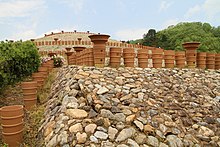| 私市円山古墳 | |
 Kisaichi Maruyama Kofun Kisaichi Maruyama Kofun | |
  | |
| Location | Ayabe, Kyoto, Japan |
|---|---|
| Region | Kansai region |
| Coordinates | 35°18′51.8″N 135°11′47″E / 35.314389°N 135.19639°E / 35.314389; 135.19639 |
| Type | Kofun |
| History | |
| Founded | c.mid-5th century |
| Periods | Kofun period |
| Site notes | |
| Public access | Yes (park) |
| National Historic Site of Japan | |
The Kisaichi Maruyama Kofun (私市円山古墳) is a Kofun period burial mound, located in the Kisaichi neighborhood of the city of Ayabe, Kyoto in the Kansai region of Japan. The tumulus was designated a National Historic Site of Japan in 1994.
Overview
The Kisaichi Maruyama Kofun is a circular enpun [ja] (円墳)-style tumulus with a diameter of 70 meters and a higher of 10 meters. It is located north of the center of the Fukuchiyama basin, in the central area of former Tanba Province, on the central reaches of the Yura River at an elevation of 94 meters. It was discovered during a survey accompanying the construction of the Kinki Expressway (currently Maizuru Wakasa Expressway) in 1988. Until then, the existence of the tumulus was unknown. Due to this discovery, the construction method of the highway was changed from a cutting to a tunnel, and the burial mound was to be preserved. The mound had a three-tiered structure, and river stones of the Yura River were used as fukiishi. Cylindrical haniwa were lined up on the flat part of the first and second tiers of the mound. In the archaeological excavation, figurative haniwa and haji ware pottery. including house-shaped and armor-shaped examples were excavated. The burial chamber consisted of a central main room where the coffins were located, and sub-chambers to the north and south. Wooden coffins was found in the central and northern chambers, and grave goods such as armor, iron spearheads, iron swords and other weapons, agricultural tools, bronze mirrors, and jewelry were excavated, along with a quiver containing 38 arrows. From the quality and quantity of the grave goods, it is assumed that the central burial was that of a king who ruled the middle reaches of the Yura River in the mid-fifth century, and the northern burials were possibly siblings, parents and children. Only agricultural tools were sub-burial on the south side, which is presumed to have been that of a servant.
When it was decided to preserve the tumulus, Ayabe City formulated the Kisaichi Maruyama tumulus environment improvement plan, re-laid the fukiishi, lined up replicas of cylindrical haniwa, and restored it as the "Maruyama Kofun Park" in May 1993. In August 2014, heavy rains caused damage to the northwestern section of the mound, which collapsed over a width of 10 meters.
The tumulus is about a two-kilometer walk from Takatsu Station on the JR West San'in Main Line.
Gallery
See also
References
- "私市円山古墳" [Kisaichi Maruyama Kofun] (in Japanese). Agency for Cultural Affairs. Retrieved August 20, 2020.
- ^ Isomura, Yukio; Sakai, Hideya (2012). (国指定史跡事典) National Historic Site Encyclopedia. 学生社. ISBN 4311750404.(in Japanese)
External links
![]() Media related to Kisaichi-Maruyama Kofun at Wikimedia Commons
Media related to Kisaichi-Maruyama Kofun at Wikimedia Commons
- Kyoto Prefecture Research Center for Archaeological Properties (in Japanese)
- Ayabe City Tourist Information (in Japanese)
- Kyoto Prefecture Tourist Information (in Japanese)


